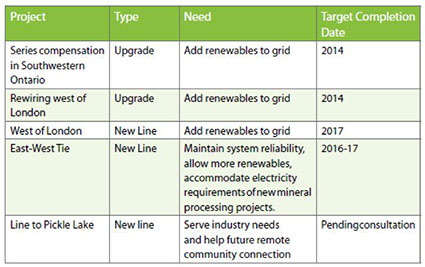The Ontario Green Energy and Green Economy Act, 2009 ("Bill 150") implemented a bold new framework implementing a broad series of coordinated actions designed to make it easier to bring renewable energy projects to life and to make Ontario a green energy leader.
One of the most significant developments under Bill 150 from a generator’s perspective was the formal recognition that transmission and distribution system constraints are a significant obstacle preventing new renewable generation from coming online. This problem has long been an issue for generators in Ontario, and Bill 150 created a policy framework designed to address this issue head on for new generation from renewable energy sources.
While much attention has been paid to the decision not to proceed with the Economic Connection Test (the “ECT”) as part of the Ontario Power Authority’s Feed-in-Tariff (FIT) Program version 2.0 (the final version 2.0 of the FIT Rules, FIT Contract, and related project documentation were posted to the OPA’s website on August 10, 2012), the ECT was just one of several innovations designed to address transmission and distribution system constraints for new renewable generation in Ontario.
Ontario’s regulatory framework continues to benefit from:
1. A Mandatory Obligation to Connect
The Electricity Act, 1998 contains a mandatory obligation under Section 25.36 requiring a distributor or transmitter to connect a renewable energy generation facility to its system. The facility must be connected in accordance with the regulations, the market rules and any licence issued by the OEB.
To trigger this mandatory connection obligation, a generator simply needs to request the connection in writing.
The mandatory obligation limits the transmitter or distributor to a consideration of whether the proposed connection meets the applicable technical, economic and other requirements prescribed by regulation or mandated by the market rules or by an order or code issued by the Board.
The obligation does not require any new renewable generation facility to be connected, if there are valid technical or economic reasons to refuse the connection. However, a new connection request cannot otherwise be refused without good reason.
2. An Obligation to Maintain Connection Information
Section 25.37 of the Electricity Act, 1998 contains requirements for transmitters, distributors, the OPA and the IESO to maintain current and prospective information about the distribution and transmission systems’ ability to accommodate generation from renewable energy generation facilities.
This information must, in-turn, be made publically available.
3. Priority Connection Access
Section 26 of the Electricity Act, 1998 provides that a transmitter or distributor must provide priority connection access to its transmission system or distribution system for prescribed renewable energy generation facilities.
This requirement takes precedence over transmitters’ and distributors’ more general obligation to provide non-discriminatory access to its system.
4. Integrated System Planning
While long-term system planning continues to be a core statutory responsibility of the Ontario Power Authority, it is the Province’s Long-Term Energy Plan (the “Plan”) that currently sets out the framework for the future of the provincial electrical system.
Under the Plan, Ontario will proceed with five priority transmission projects needed immediately for reliability, renewable energy growth, and changing demand. Each of these five projects is summarized below:

In addition, Section 70 of the Ontario Energy Board Act, 1998 includes a requirement that all licensed electricity distributors and transmitters prepare and file plans, in the manner and at the times mandated by the Board, regarding the expansion or reinforcement of the licensee’s system to accommodate the connection of renewable energy generation facilities, and the development and implementation of the smart grid.
The Ontario Energy Board has subsequently released filing requirements for distribution system plans (EB-2009-0397) requiring licensed distributors to file these plans once every four years, in conjunction with their cost-of-service rate applications. The plans are to include an assessment of a distributor's current capacity to accommodate new renewable generation, as well as a plan to connect new renewable generation.
Conclusions
Despite the decision not to proceed with the Economic Connection Test, there have been various other changes to the regulatory framework in Ontario designed to promote the use and generation of electricity from renewable energy sources in a manner consistent with the policies of the Government of Ontario, including the timely expansion or reinforcement of transmission systems and distribution systems to accommodate the connection of renewable energy generation facilities.
The preliminary facts are that these changes have shown some signs of success. Several new projects have been announced on the transmission side with an explicit objective of adding new renewable generation to the grid. And the first distribution system plans are now being filed with the Ontario Energy Board as part of distributors cost of service applications.
John A.D. Vellone is an associate in the Toronto office of Borden Ladner Gervais LLP and is a member of the Firm's Electricity Markets Group. He practises corporate/commercial and regulatory law with a focus on energy law and matters relating to the Ontario electricity sector. John can be reached directly at 416.367.6730 or jvellone@blg.com.




